How to produce biogas from manure: an overview of the basic principles and design of a production plant
Farmers annually face the problem of manure disposal.The considerable funds required to organize its removal and burial are wasted. But there is a way that allows you not only to save your money, but also to make this natural product serve you for your benefit.
Thrifty owners have long been putting into practice eco-technology that makes it possible to obtain biogas from manure and use the result as fuel.
Therefore, in our material we will talk about the technology for producing biogas, and we will also talk about how to build a bioenergy plant.
The content of the article:
Advantages of using biotechnology
Technology obtaining biofuel from various natural sources is not new. Research in this area began at the end of the 18th century and developed successfully in the 19th century. In the Soviet Union, the first bioenergy plant was created in the forties of the last century.
Biotechnologies have long been used in many countries, but today they are gaining particular importance. Due to the deteriorating environmental situation on the planet and the high cost of energy, many are turning their attention to alternative sources of energy and heat.
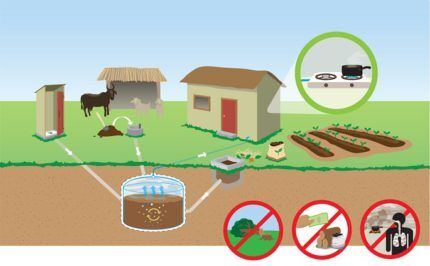
Of course, manure is a very valuable fertilizer, and if there are two cows on the farm, then there are no problems with its use. It’s a different matter when it comes to farms with large and medium-sized livestock, where tons of foul-smelling and rotting biological material are generated per year.
In order for manure to turn into high-quality fertilizer, areas with a certain temperature regime are needed, and this is an extra expense. Therefore, many farmers store it wherever they can and then take it to the fields.
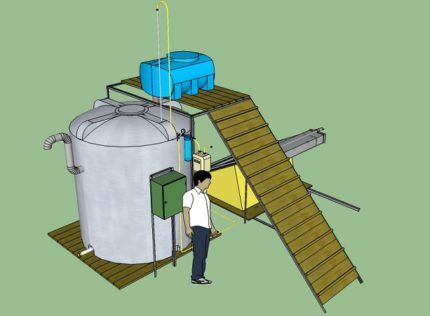
If storage conditions are not met, up to 40% of nitrogen and the bulk of phosphorus evaporate from manure, which significantly worsens its quality indicators. In addition, methane gas is released into the atmosphere, which has a negative impact on the environmental situation of the planet.
Modern biotechnologies make it possible not only to neutralize the harmful effects of methane on the environment, but also to make it serve for the benefit of people, while reaping considerable economic benefits. As a result processing manure produces biogas, from which thousands of kW of energy can then be obtained, and the production waste represents a very valuable anaerobic fertilizer.
Mechanism of gas formation from organic raw materials
Biogas is a volatile substance without color or any odor, which contains up to 70% methane. In terms of its quality indicators, it approaches the traditional type of fuel – natural gas. Has a good calorific value, 1m3 biogas produces as much heat as is produced by burning one and a half kilograms of coal.
We owe the formation of biogas to anaerobic bacteria, which actively work to decompose organic raw materials, which include farm animal manure, bird droppings, and any plant waste.
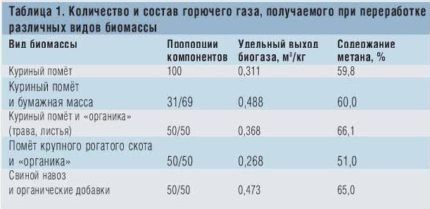
To activate the process, it is necessary to create favorable conditions for the life of bacteria. They should be similar to those in which microorganisms develop in a natural reservoir - in the stomach of animals, where it is warm and there is no oxygen.
Actually, these are the two main conditions that contribute to the miraculous transformation of rotting manure into environmentally friendly fuel and valuable fertilizers.
To produce biogas, you need a sealed reactor without access to air, where the process of fermentation of manure and its decomposition into components will take place:
- methane (up to 70%);
- carbon dioxide (approximately 30%);
- other gaseous substances (1-2%).
The resulting gases rise to the top of the container, from where they are then pumped out, and the residual product settles down - high-quality organic fertilizer, which, as a result of processing, has retained all the valuable substances present in the manure - nitrogen and phosphorus, and has lost a significant part of pathogenic microorganisms.
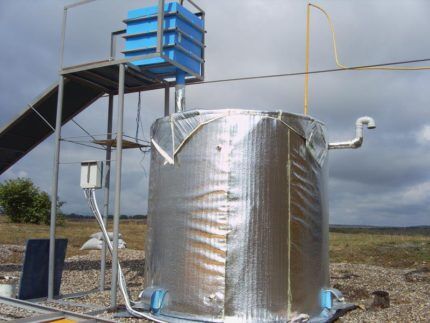
The second important condition for the effective decomposition of manure and the formation of biogas is compliance with the temperature regime. Bacteria taking part in the process are activated at temperatures from +30 degrees.
Moreover, manure contains two types of bacteria:
- mesophilic. Their life activity occurs at a temperature of +30 – +40 degrees;
- thermophilic. To reproduce them, it is necessary to maintain a temperature regime of +50 (+60) degrees.
The processing time of raw materials in installations of the first type depends on the composition of the mixture and ranges from 12 to 30 days. At the same time, 1 liter of useful reactor area produces 2 liters of biofuel. When using installations of the second type, the production time of the final product is reduced to three days, and the amount of biogas increases to 4.5 liters.

Despite the fact that the efficiency of thermophilic plants is tens of times higher, they are used much less frequently, since maintaining high temperatures in the reactor is associated with high costs.
Maintenance and maintenance of mesophilic type plants is cheaper, so most farms use them to produce biogas.
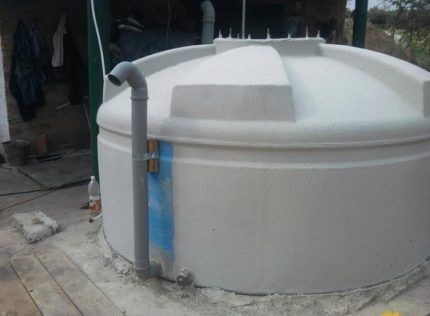
Calculations of the efficiency of biogas use
Simple calculations will help you evaluate all the benefits of using alternative biofuels. One cow weighing 500 kg produces approximately 35-40 kg of manure per day. This amount is enough to get about 1.5 m3 biogas, from which 3 kW/h of electricity can be generated.
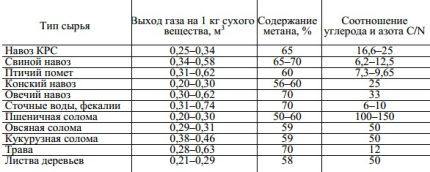
To obtain biofuel, you can use either one type of organic raw material or mixtures of several components with a humidity of 85-90%. It is important that they do not contain foreign chemical impurities that negatively affect the processing process.
The simplest recipe for the mixture was invented back in 2000 by a Russian man from the Lipetsk region, who built with his own hands a simple installation for producing biogas.He mixed 1,500 kg of cow manure with 3,500 kg of various plant waste, added water (about 65% of the weight of all ingredients) and heated the mixture to 35 degrees.
In two weeks, free fuel is ready. This small installation produced 40 m3 gas per day, which was enough to heat the house and outbuildings for six months.
Options for biofuel production plants
After making the calculations, you need to decide how to make the installation in order to obtain biogas in accordance with the needs of your farm. If the number of livestock is small, then the simplest option is suitable, which is easy to make with your own hands from available materials.
For large farms that have a constant source of large quantities of raw materials, it is advisable to build an industrial automated biogas system. In this case, it is unlikely that it will be possible to do without the involvement of specialists who will develop the project and install the installation at a professional level.
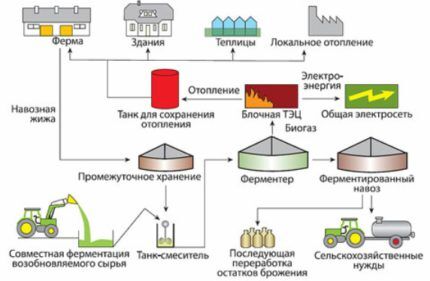
Today there are dozens of companies that can offer many options: from ready-made solutions to the development of an individual project. To reduce the cost of construction, you can cooperate with neighboring farms (if there are any nearby) and build one installation for producing biogas for all of them.
It should be noted that to build even a small installation, it is necessary to draw up the relevant documents, make a technological diagram, a plan for the placement of equipment and ventilation (if the equipment is installed indoors), and go through approval procedures with the SES, fire and gas inspection.
A mini-plant for the production of gas to cover the needs of a small private household can be made with your own hands, focusing on the design and specific design of installations produced on an industrial scale.
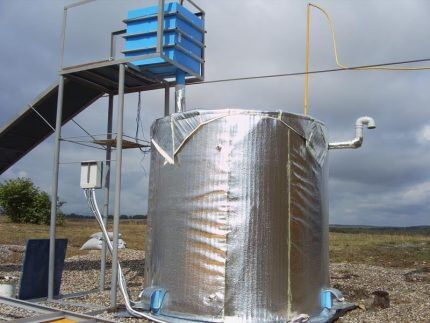
Independent craftsmen who decide to build their own installation need to stock up on a water container, water supply or sewer plastic pipes, corner bends, seals and a cylinder for storing the gas produced in the installation.
Features of the biogas system
A complete biogas plant is a complex system consisting of:
- Bioreactor, where the process of decomposition of manure takes place;
- Automated organic waste supply system;
- Biomass mixing devices;
- Equipment to maintain optimal temperature conditions;
- Gas tanks – gas storage tanks;
- Receiver for waste solid waste.
All of the above elements are installed in industrial installations operating in automatic mode. Household reactors, as a rule, have a more simplified design.
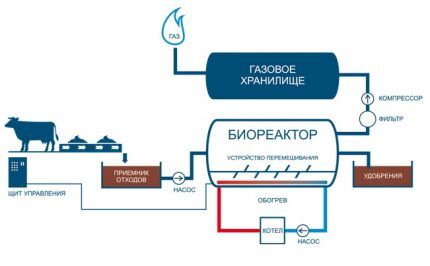
Operating principle of the installation
The main element of the system is the bioreactor. There are several options for its implementation, the main thing is to ensure the tightness of the structure and prevent the ingress of oxygen. It can be made in the form of a metal container of various shapes (usually cylindrical), located on the surface. Often 50 cc empty fuel tanks are used for these purposes.
You can purchase ready-made collapsible containers. Their advantage is the ability to quickly disassemble and, if necessary, transport to another location. It is advisable to use industrial surface installations on large farms where there is a constant influx of large quantities of organic raw materials.
For small farmsteads, the option of underground placement of the tank is more suitable. An underground bunker is built from brick or concrete. You can bury ready-made containers in the ground, for example, barrels made of metal, stainless steel or PVC. It is also possible to place them superficially on the street or in a specially designated room with good ventilation.
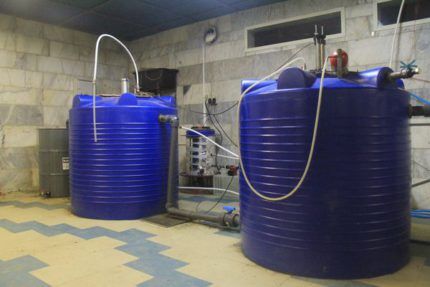
Regardless of where and how the reactor is located, it is equipped with a bunker for loading manure. Before loading the raw material, it must undergo preliminary preparation: it is crushed into fractions no larger than 0.7 mm and diluted with water. Ideally, the substrate humidity should be about 90%.
Automated industrial-type installations are equipped with a raw material supply system, including a receiver in which the mixture is brought to the required moisture level, a water supply pipeline and a pumping unit for pumping the mass into the bioreactor.
In home installations for preparing the substrate, separate containers are used where the waste is crushed and mixed with water. Then the mass is loaded into the receiving compartment. In reactors located underground, the hopper for receiving the substrate is brought out, and the prepared mixture flows by gravity through a pipeline into the fermentation chamber.
If the reactor is located on the ground or indoors, the inlet pipe with the receiving device can be located in the lower side of the tank. It is also possible to bring the pipe to the top and put a socket on its neck. In this case, the biomass will have to be supplied using a pump.
It is also necessary to provide an outlet hole in the bioreactor, which is made almost at the bottom of the container on the opposite side from the input hopper. When placed underground, the outlet pipe is installed obliquely upward and leads to a waste receptacle, shaped like a rectangular box. Its upper edge should be below the level of the inlet.
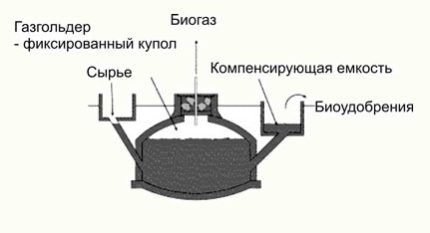
The process proceeds as follows: the input hopper receives a new batch of substrate, which flows into the reactor, at the same time the same amount of waste mass rises through a pipe into the waste receiver, from where it is subsequently scooped out and used as a high-quality biofertilizer.
Biogas is stored in a gas tank. Most often it is located directly on the roof of the reactor and has the shape of a dome or cone. It is made from roofing iron, and then, to prevent corrosion processes, it is painted with several layers of oil paint.
In industrial installations designed to produce large quantities of gas, the gas tank is often constructed in the form of a separate tank connected to the reactor by a pipeline.
The gas produced by fermentation is not suitable for use because it contains a large amount of water vapor and will not burn in this form. To purify it from water fractions, the gas is passed through a water seal. To do this, a pipe is removed from the gas tank, through which the biogas enters a container with water, and from there it is supplied to consumers through a plastic or metal pipe.
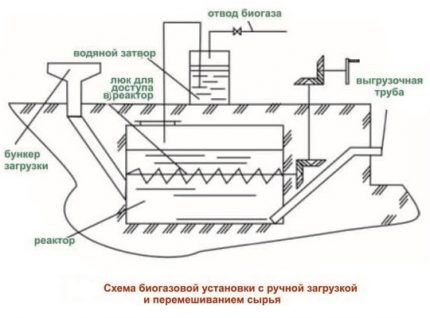
In some cases, special gas holder bags made of polyvinyl chloride are used to store gas. The bags are placed next to the installation and gradually filled with gas.As they are filled, the elastic material inflates and the volume of the bags increases, allowing you to temporarily store more of the final product if necessary.
Conditions for efficient operation of a bioreactor
For efficient operation of the installation and intensive release of biogas, uniform fermentation of the organic substrate is necessary. The mixture must be in constant motion. Otherwise, a crust forms on it, the decomposition process slows down, and as a result, less gas is produced than initially calculated.
To ensure active mixing of the biomass, submersible or inclined mixers equipped with an electric drive are installed in the upper or side part of a typical reactor. In homemade installations, mixing is done mechanically using a device resembling a household mixer. It can be controlled manually or equipped with an electric drive.
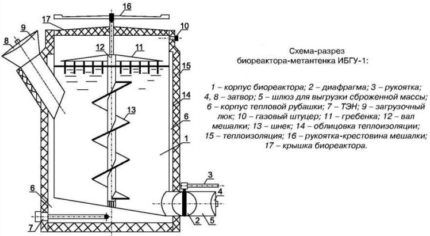
One of the most important conditions for producing biogas is maintaining the required temperature in the reactor. Heating can be accomplished in several ways. In stationary installations, automated heating systems are used, which turn on when the temperature drops below a predetermined level, and turn off when the required temperature is reached.
Can be used for heating gas boilers, carry out direct heating with electric heating devices or build a heating element into the base of the container.
To reduce heat loss, it is recommended to build a small frame around the reactor with a layer of glass wool or cover the installation with thermal insulation. Has good thermal insulation properties expanded polystyrene and its other varieties.
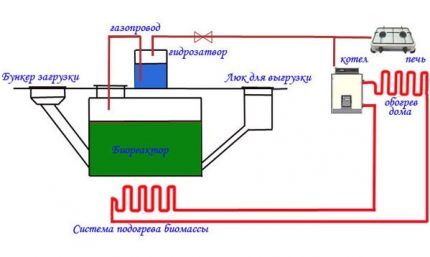
Determining the required volume
The volume of the reactor is determined based on the daily amount of manure produced on the farm. It is also necessary to take into account the type of raw material, temperature and fermentation time. For the installation to fully operate, the container is filled to 85-90% of the volume, at least 10% must remain free for gas to escape.
The process of decomposition of organic matter in a mesophilic installation at an average temperature of 35 degrees lasts from 12 days, after which the fermented residues are removed and the reactor is filled with a new portion of the substrate. Since waste is diluted with water up to 90% before being sent to the reactor, the amount of liquid must also be taken into account when determining the daily load.
Based on the given indicators, the volume of the reactor will be equal to the daily amount of prepared substrate (manure with water) multiplied by 12 (the time required for biomass decomposition) and increased by 10% (free volume of the container).
Construction of an underground structure
Now let's talk about the simplest installation that allows you to get biogas at home at the lowest cost. Consider building an underground system. To make it, you need to dig a hole, its base and walls are filled with reinforced expanded clay concrete.
Inlet and outlet openings are located on opposite sides of the chamber, where inclined pipes are mounted for supplying the substrate and pumping out the waste mass.
The outlet pipe with a diameter of approximately 7 cm should be located almost at the very bottom of the bunker, its other end is mounted in a rectangular compensating tank into which waste will be pumped. The pipeline for supplying the substrate is located approximately 50 cm from the bottom and has a diameter of 25-35 cm. The upper part of the pipe enters the compartment for receiving raw materials.
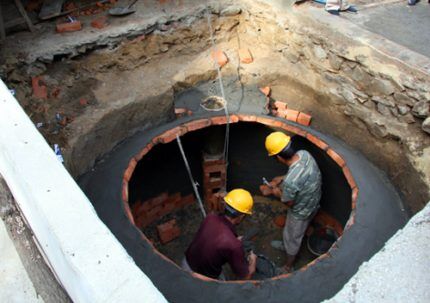
The upper part of the bunker is a gas holder, which has a dome or cone shape. It is made of metal sheets or roofing iron. You can also complete the structure with brickwork, which is then covered with steel mesh and plastered. You need to make a sealed hatch on top of the gas tank, remove the gas pipe passing through the water seal and install a valve to relieve gas pressure.
To mix the substrate, you can equip the installation with a drainage system operating on the principle of bubbling. To do this, vertically fix plastic pipes inside the structure so that their upper edge is above the substrate layer. Make lots of holes in them. Gas under pressure will fall down, and rising up, gas bubbles will mix the biomass in the container.
If you do not want to build a concrete bunker, you can buy a ready-made PVC container. To preserve heat, it must be surrounded by a layer of thermal insulation - polystyrene foam. The bottom of the pit is filled with a 10 cm layer of reinforced concrete.Tanks made of polyvinyl chloride can be used if the reactor volume does not exceed 3 m3.
Conclusions and useful video on the topic
You will learn how to make the simplest installation from an ordinary barrel if you watch the video:
You can see how the construction of an underground reactor takes place in the video:
How manure is loaded into an underground installation is shown in the following video:
An installation for producing biogas from manure will allow you to significantly save on heat and electricity costs, and use organic material, which is available in abundance in every farm, for a good cause. Before starting construction, everything must be carefully calculated and prepared.
The simplest reactor can be made in a few days with your own hands, using available materials. If the farm is large, then it is best to buy a ready-made installation or contact specialists.
If, while reading the information presented, you have questions or have suggestions that you would like to share with site visitors, please leave comments in the block below.




Organic farming is just beginning to gain momentum here. More and more farms are abandoning chemical fertilizers in favor of biofertilizers. But in many farms, manure is actually used unprofitably due to the fact that it is difficult to provide it with the correct ripening conditions. In this case, it might actually make sense for large farms to switch to using manure as biofuel.
Hello. In 1940, organic farming began to become widespread.And in Rus', manure has been used since ancient times in fields and vegetable gardens. Regarding biofuels, I can also say that this is not a new product, but it is not yet entirely profitable. I read somewhere, when my father was still farming, that on a farm of 50 thousand pig heads, the purchase of a biogas plant will pay off in about 7 years.
How much did a cubic meter of gas cost in 1940???
Greetings! My humble opinion: currently, producing biofuel from manure is unprofitable, costly and even harmful to the environment. My opinion is based on visiting and studying the work of the Luchki BS in the Belgorod region. The cost of 1 kW/h is 7 rubles. This is 2 times more than the Russian average. This means that the more such BS (biological stations), the greater the losses! Calculations show that the ambitious Luchki project will pay off in 7 years, even taking into account 85% of state subsidies. There is nothing to say about the payback of completely commercial projects.
In addition to this purely economic aspect, there are other disadvantages that do not allow putting biogas production on stream:
— biogas is explosive — its main component is methane;
- production requires the participation of highly qualified workers - it is very difficult to find such workers in rural areas;
- after obtaining biogas, waste manure must be disposed of - this is expensive.
These are just the main problems that biofuel producers will face.
Greetings, I’ll comment on your humble opinion, otherwise suddenly someone will actually believe what you wrote.
I myself am involved in autonomous gasification (gas tanks) and I would like to note that when a person is faced with the choice of paying for the equipment in 7? years, but tomorrow he can press a button and get heat at home, hot water, a gas stove, having paid for it, or continue to buy coal, firewood, chop, carry, heat, languish from the heat in the evening, and freeze in the morning, he will choose the first, having a budget less than a gas connection in most cases.
As for your “study” and visit... The cost of 1 kW is 7 rubles... kW of what? As I understand it, electricity (??), you mean what an industrial gas generator installation costs? So it costs from 4 million rubles (Kamaz), or are you confusing a legal entity and an individual?
So for legal entities, a kW of electricity costs on average 9 rubles, and for individuals from 4x by region.
What are these calculations? Give the power of the installation, its cost, the cost of heating, delivery and other things, gas output?
The so-called disadvantages:
-Biogas is explosive, this is the greatest discovery since the bicycle, I won’t comment, and it’s clear to everyone.
-You won’t believe it, “highly qualified specialists”, but essentially ordinary gas workers with clearances in the regions are a dime a dozen, just give them the job, as I say as a person in the subject.
-Disposal?? In fact, the bigger point is not even in the gas, but in the sale of high-quality fertilizer, which for some reason you call waste manure.
In just a few words I described the main problems that a thinking person who reads your comment will face.
When I was on an exchange in the Netherlands, where agriculture and livestock farming are very developed, in particular, I saw mesophilic installations in many places.They are mega popular there and enjoy subsidies from the state.
Since the Netherlands, like the whole of Europe, is obsessed with ecology, 99% of farmers, both private and individual farms, firms and companies, have long had both mesophilic and thermophilic installations (depending on the size of the farm). It would also be nice for us to pay attention to this, but for now, I think, only private traders will be able to implement this, and with a well-functioning and profitable business, since we will not have subsidies in the near future, as in Europe.
I read about examples of the use of biogas plants in Russia. Moreover, both completely handicraft ones, which operate only in the warm season, and full-fledged ones, producing gas year-round. But we must understand that these are all enthusiasts. We do not have subsidies for this business and will not have them in the foreseeable future. But large farms, which have their own money, operate according to a well-established scheme and categorically do not like innovations.
Agree with you. In Russia, we have about 5 farms in total with a well-functioning biogas system, as far as I know (I could be wrong). That's why... a man decided to start farming. He went and AKKOR allocated him land (this is real), the bank gave him support for small businesses. There is barely enough for equipment and the first sowing (it is more profitable for livestock to grow their own grain), and a small livestock. As long as the business develops, the loans will pay off... for the most part, farms are now operating with low returns.
I looked at a low-capacity methane generator based on an ordinary (!) barrel - it was clear and understandable, but a number of questions arose.
As shown, it’s winter all around, the outside of the barrel is insulated (covered with a fur coat).Is there enough natural heat to keep the temperature inside the barrel at 30 - 35 degrees Celsius? Is heating sometimes required? This can be automated.
Then there is another point - when loading organic matter and unloading waste (fertilizer), air (oxygen) can get into the barrel! Gas may be explosive! There is an upper explosive limit for the gas mixture (almost pure methane and some oxygen), as well as a lower explosive limit (air and some methane). Therefore, I think it is necessary to provide a safety valve at the top of the barrel to relieve the sometimes occurring excess methane pressure.
I'm interested, I'm still studying, but I think I'll start in the spring. If anyone is interested, please help with advice.
In the small barrel shown, the waste loading pipe and the recycling pipe are almost next to each other and at the same height! And the installation explanations clearly indicate that these two pipes should be located oppositely, and the pipe with waste raw materials should come out almost at the very bottom! Loading d.b. higher than the previous one by at least 50 cm! The question is: will the proposed option work?
Will work in Siberia in winter 25-28 degrees